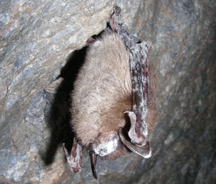 I almost skipped the news that another white nose syndrome (WNS) site has been confirmed in Missouri, because WNS was confirmed in the state last year (covered here), and the new site didn’t seem to represent a significant change.
I almost skipped the news that another white nose syndrome (WNS) site has been confirmed in Missouri, because WNS was confirmed in the state last year (covered here), and the new site didn’t seem to represent a significant change.
Leave it to ProMED, however, to point out that the new site, in Onondaga Cave at Onondaga Cave State Park in Crawford County, is the western-most confirmed site of white nose syndrome in bats. So it is significant after all.
ProMED got the news from OzarksFirst.com, here.
I read the press release from the Missouri Department of Natural Resources, and you can too.
However, the fungus that causes white nose syndrome has been found farther west, in Oklahoma, although it did not cause white nose syndrome in bats there. That might be because of the warmer, shorter winters in Oklahoma or it might be because it was associated with a different species of bat. You can read the Bat Conservation International press release for more info on the situation in Oklahoma. (It’s a PDF.)
Photo: Little brown bat with visible fungus collected at Onondaga Cave. Photo credit: MDC/Shelly Colatskie


 A study published recently in
A study published recently in Wisconsin researchers have confirmed that Geomyces destructans, the fungus that causes white nose syndrome (WNS) in bats, persists in caves long after all the bats in the cave have died off.
Wisconsin researchers have confirmed that Geomyces destructans, the fungus that causes white nose syndrome (WNS) in bats, persists in caves long after all the bats in the cave have died off.
